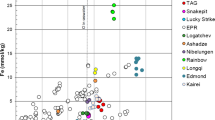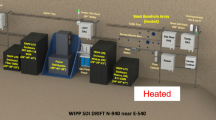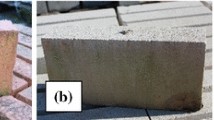Abstract
An analytical model for heat conduction through brine-spongy ice is developed. This model fills a gap in knowledge related to transient heat conduction to a two-phase substrate which is crucial for modeling transient icing and deicing of cold surfaces in contact with salt water. The core of the model is based on the phase change of pure ice and brine pockets trapped in the structure of spongy ice. Freezing of brine pockets causes the release of the latent heat of fusion that is considered as the source of heat generation distributed throughout the brine-spongy ice. A nonlinear partial differential equation and a number of equations of state for ice, brine, and brine-spongy ice create governing equations of heat transfer through brine-spongy ice. A standard numerical scheme solves the set of equations in various initial conditions. The variation of temperature, volume fraction of brine and salinity of brine pockets are calculated numerically. Experimental samples of brine-spongy ice are examined under transient conditions and their surface temperatures are captured using an infrared thermal camera. The numerical results, which are for various overall salinities, are closely aligned with the measured surface temperatures.



















Similar content being viewed by others
Abbreviations
- \( {\text{c}}_{\text{b}} \) :
-
Specific heat capacity of brine (J/kg K)
- \( {\text{c}}_{\text{e}} \) :
-
Equivalent specific heat capacity of brine-spongy ice (J/kg K)
- \( {\text{c}}_{\text{i}} \) :
-
Specific heat capacity of ice (J/kg K)
- \( {\text{c}}_{\text{s}} \) :
-
Specific heat capacity of brine-spongy ice (J/kg K)
- \( {\text{k}}_{\text{b}} \) :
-
Thermal conductivity of brine (W/m K)
- \( {\text{k}}_{\text{i}} \) :
-
Thermal conductivity of ice (W/m K)
- \( {\text{k}}_{\text{s}} \) :
-
Thermal conductivity of brine-spongy ice (W/m K)
- \( {\text{L}} \) :
-
Ice sample length (m)
- \( {\text{L}}_{\text{Hb}} \) :
-
Latent heat of fusion of brine (J/kg)
- \( {\text{Q}}_{\text{i}} \) :
-
Input heat flux (J/s)
- \( {\text{Q}}_{\text{o}} \) :
-
Output heat flux (J/s)
- \( {\text{Q}}_{\text{g}}^{\prime \prime \prime } \) :
-
Volumetric heat generation (J/m3)
- \( {\dot{\text{Q}}}_{\text{g}}^{\prime \prime \prime } \) :
-
Rate of volumetric heat generation (J/m3 s)
- \( {\text{S}} \) :
-
Overall salinity (‰)
- \( {\text{S}}_{\text{b}} \) :
-
Salinity of brine pockets (‰)
- \( {\text{T}} \) :
-
Temperature (oC)
- \( {\text{T}}_{\text{L}} \) :
-
Temperature at \( x = L \) (oC)
- \( {\text{T}}_{\text{i}} \) :
-
Initial temperature (oC)
- \( {\text{T}}_{\text{s}} \) :
-
Contact temperature (oC)
- \( {\text{t}} \) :
-
Time (s)
- \( {\text{t}}_{0} \) :
-
Initial time (s)
- \( {\text{V}}_{\text{b}} \) :
-
Volume of brine pocket in the element of brine-spongy ice (m3)
- \( {\text{V}}_{\text{Fb}} \) :
-
Volume fraction of brine (—)
- \( {\text{V}}_{\text{i}} \) :
-
Volume of ice in the element of brine-spongy ice (m3)
- \( {\text{V}}_{\text{s}} \) :
-
Volume of the element of brine-spongy ice (m3)
- \( \upalpha_{\text{cb}} \) :
-
Coefficient of the equation of specific heat capacity of brine (—)
- \( \upalpha_{\text{ci}} \) :
-
Coefficient of the equation of specific heat capacity of ice (—)
- \( \upalpha_{\text{kb}} \) :
-
Coefficient of the equation of thermal conductivity of brine (—)
- \( \upalpha_{\text{ki}} \) :
-
Coefficient of the equation of thermal conductivity of ice (—)
- \( \upalpha_{\text{LHb}} \) :
-
Coefficient of the equation of latent heat of fusion of brine (—)
- \( \upalpha_{\text{sb}} \) :
-
Coefficient of the equation of salinity of brine (—)
- \( \upalpha_{{\uprho{\text{b}}}} \) :
-
Coefficient of the equation of density of brine (—)
- \( \upalpha_{{\uprho{\text{i}}}} \) :
-
Coefficient of the equation of density of ice (—)
- \( \updelta{\text{Q}}_{\text{g}}^{\prime \prime \prime } \) :
-
Variation of volumetric heat generation (J/m3)
- \( \updelta{\text{t}} \) :
-
Time interval (s)
- \( \updelta{\text{V}}_{\text{Fb}} \) :
-
Variation of volume fraction of brine (—)
- \( \updelta{\text{V}}_{\text{i}} \) :
-
Variation of volume of ice (m3)
- \( \uprho_{\text{b}} \) :
-
Density of brine (kg/m3)
- \( \uprho_{\text{e}} \) :
-
Equivalent density of brine-spongy ice (kg/m3)
- \( \uprho_{\text{i}} \) :
-
Density of ice (kg/m3)
- \( \uprho_{\text{s}} \) :
-
Density of brine-spongy ice (kg/m3)
References
Sugawara M, Komatsu Y, Onodera D, Beer H (2012) Three-dimensional freezing of water in a copper foils porous layer around a coolant-carrying tube. Heat Mass Transf 48:1847–1854. doi:10.1007/s00231-012-1030-x
Sugawara M, Komatsu Y, Beer H (2008) Melting and freezing around a horizontal cylinder placed in a square cavity. Heat Mass Transf 45:83–92. doi:10.1007/s00231-008-0403-7
Sugawara M, Onodera T, Komatsu Y et al (2008) Freezing of water saturated in aluminum wool mats. Heat Mass Transf 44:835–843. doi:10.1007/s00231-007-0300-5
Yu Z-T, Fan L-W, Hu Y-C, Cen K-F (2010) Perturbation solution to heat conduction in melting or solidification with heat generation. Heat Mass Transf 46:479–483. doi:10.1007/s00231-010-0596-4
Lakzian E, Parsian A, Lakzian K (2016) Numerical simulation of melting ice around a floating by microwaves. Heat Mass Transf 52:429–436
Odukoya A, Naterer GF (2015) Heat transfer and multiphase flow with hydrate formation in subsea pipelines. Heat Mass Transf 51:901–909. doi:10.1109/OCEANS.2014.7003017
Makkonen L (1987) Salinity and growth rate of ice formed by sea spray. Cold Reg Sci Technol 14:163–171
Saha D, Dehghani SR, Pope K, Muzychka Y (2016) Temperature distribution during solidification of saline and fresh water droplets after striking a super-cooled surface. In: Arctic technology conference
Lozowski EP, Blackmore RZ, Forest TW, Shi J (1996) Spongy icing in the marine environment. American Society of Mechanical Engineers, New York
Weeks WF, Ackley SF (1986) The growth, structure, and properties of sea ice. In: Norbert U (ed) The geophysics of sea ice. Springer, US, pp 9–164
Bodaghkhani A, Dehghani SR, Muzychka YS, Colbourne B (2016) Understanding spray cloud formation by wave impact on marine objects. Cold Reg Sci Technol 129:114–136
Dehghani-Sanij AR, Dehghani SR, Naterer GF, Muzychka YS (2017) Sea spray icing phenomena on marine vessels and offshore structures: review and formulation. Ocean Eng 132:25–39
Panov VV (1978) Icing of ships. Polar Geogr 2:166–186
Paul Zakrzewski W, Lozowski EP, Muggeridge D (1988) Estimating the extent of the spraying zone on a sea-going ship. Ocean Eng 15:413–429. doi:10.1016/0029-8018(88)90008-X
Lozowski EP, Szilder K, Makkonen L (2000) Computer simulation of marine ice accretion. Philos Trans R Soc London A Math Phys Eng Sci 358:2811–2845. doi:10.1098/rsta.2000.0687
Dehghani SR, Naterer GF, Muzychka YS (2016) Droplet size and velocity distributions of wave-impact sea spray over a marine vessel. Cold Reg Sci Technol 132:60–67. doi:10.1016/j.coldregions.2016.09.013
Dehghani SR, Muzychka YS, Naterer GF (2016) Droplet trajectories of wave-impact sea spray on a marine vessel. Cold Reg Sci Technol 127:1–9. doi:10.1016/j.coldregions.2016.03.010
Fazelpour A, Dehghani SR, Masek V, Muzychka YS (2016) Infrared image analysis for estimation of ice load on structures. In: Arctic technology conference
Dehghani SR, Muzychka YS, Naterer GF (2017) Water breakup mechanisms for wave-impact sea spray on a vessel bow. Ocean Eng 134:50–61
Shakeel T (1987) Dynamics of spontaneous pattern formation in dendritic ice crystal growth. PhD Thesis, The State University of New York at Buffalo
Glicksman ME (2012) Mechanism of dendritic branching. Metall Mater Trans A 43:391–404. doi:10.1007/s11663-011-9594-2
Makkonen L (1990) The origin of spongy ice. In: Proceedings of the 10th IAHR symposium ice, pp 1022–1030
Gates EM, Narten R, Lozowski EP, Makkonen L (1986) Marine icing and spongy ice. In: Proceedings of the 8th IAHR symposium ice, pp 153–163
Blackmore RZ, Lozowski EP (2003) Spongy icing modelling: progress and prospects. In: Thirteenth international offshore polar engineering conference
Shan X, Shu N (2006) Discussion on methods of de-icing for overhead transmission lines. Gaodianya Jishu/High Volt Eng 32:25–27
Laforte JLL, Allaire MAA, Laflamme J (1998) State-of-the-art on power line de-icing. Atmos Res 46:143–158. doi:10.1016/S0169-8095(97)00057-4
Thomas SK, Cassoni RP, MacArthur CD (1996) Aircraft anti-icing and de-icing techniques and modeling. J Aircr 33:841–854
Embry GD, Erskine RW, Haslim LA et al (1990) Electro-expulsive separation system shipboard applications. Nav Eng J 102:55–66
Weeks W (2010) On sea ice. University of Alaska Press
Blackmore RZ, Lozowski EP (1998) A theoretical spongy spray icing model with surficial structure. Atmos Res 49:267–288. doi:10.1016/S0169-8095(98)00087-8
Macklin WC, Ryan BF (1962) On the formation of spongy ice. Q J R Meteorol Soc 88:548–549
Blackmore RZ, Makkonen L, Lozowski EP (2002) A new model of spongy icing from first principles. J Geophys Res Atmos 107:1–15. doi:10.1029/2001JD001223
Lozowski EP, Oleskiw M, Blackmore RZ, et al (2005) Spongy icing revisited: measurements of ice accretion liquid fraction in two icing wind tunnels. In: 43rd AIAA Aerospace Sciences Meeting Exhibit AIAA Reno, pp 2005–2658
Frankenstein G, Garner R (1967) Equations for determining the brine volume of sea ice from −0.5 °C to −22.9 °C. J Glaciol 6:943–944
Ozisik MN (1993) Heat conduction. Wiley, New York
Cox GFN, Weeks WF (1975) Brine drainage and initial salt entrapment in sodium chloride ice. DTIC Document
Acknowledgements
The authors gratefully acknowledge the financial support of Statoil (Norway), MITACS, and Petroleum Research Newfoundland and Labrador (PRNL) (IT03198) for this research.
Author information
Authors and Affiliations
Corresponding author
Rights and permissions
About this article
Cite this article
Dehghani, S.R., Naterer, G.F. & Muzychka, Y.S. Transient heat conduction through a substrate of brine-spongy ice. Heat Mass Transfer 53, 2719–2729 (2017). https://doi.org/10.1007/s00231-017-2016-5
Received:
Accepted:
Published:
Issue Date:
DOI: https://doi.org/10.1007/s00231-017-2016-5




